2018 上半年安徽教师资格初中英语学科知识与教学能力真
题及答案
一、单项选择题(本大题共 20 小题,每小题 2 分,共 40 分)
在每小题列出的四个备选项中选择一个最佳答案。
1. The similarity between the English consonants/p/,/b/,and/m/is that they are
all_________.
A. fricative
B. plosive
C. labial-dental
D. bilabial
2. Which of the following is a back vowel in English?
A./
B./
C./
ɜː/
ɔ:/
ʌ/
D./e/
3. There is only one playground slide in this school, so the students have to
take
_________
to use it.
A. turns
B. the turn
C. a turn
D. the turns
4. Out of everyone's expectation, Johnson suddenly returned _________ a rainy night.
A. at
B. in
C. on
D. during
5. She_________
it very well when she described her younger brother as "brilliant
but lazy".
A. put
�
B. made
C. assumed
D. interpreted
6. We don't think
possible to master a foreign language without much memory work.
A. this
B. that
C. its
D. it
7. _________the same mistakes in the annual financial report again made his boss
very angry.
A. His having made
B. He having made
C. He had made
D. He has made
8. I would have told him the answer, but I
_________so busy then.
A. had been
B. were
C. was
D. would be
9. The use of the expression "I won't bore you with all the details..." indicates
that people
usually observe
the_________Maxim in their daily conversations.
A. Quantity
B. Quality
C. Relevance
D. Manner
10. Which of the following is an evaluative move used by a teacher in class to comment
on students’performance?
A. Initiation move.
B. Follow-up move.
C. Framing move.
�
D. Repair move.
11. Which of the following activities is NOT typical of the Task-Based Language
Teaching method?
A. Problem-solving activities.
B. Opinion exchange activities.
C. Information-gap activities.
D. Pattern practice activities.
12. If a teacher shows students how to do an activity before they start doing it,
he/she is using the technique of_________.
A. presentation
B. demonstration
C. elicitation
D. evaluation
13. When a teacher asks students to discuss how a text is organized, he/she is most
likely to help them_________.
A. evaluate the content of the text
B. analyze the structure of the passage
C. understand the intention of the writer
D. distinguish the fact from the opinions
14. Which of the following practices can encourage students to read an article
critically?
A. Evaluating its point of view.
B. Finding out the facts.
C. Finding detailed information.
D. Doing translation exercises.
15. Which of the following is a display question used by teachers in class?
A. If you were the girl in the story, would you behave like her?
B. Do you like the story Girl the Thumb, why or why not?
C. Do you agree that the girl was a kind-hearted person?
D. What happened to the girl at the end of the story?
�
16. Which of the following would a teacher encourage students to do in order to
develop their cognitive strategies ?
A. To make a study plan.
B. To summarize a story.
C. To read a text aloud.
D. To do pattern drills.
17. Which of the following exercises would a teacher most probably use if he/she
wants to help students de- velop their discourse competence.
A. Paraphrasing sentences.
B. Translating sentences.
C. Unscrambling sentences.
D. Transforming sentences.
18. The advantages of pair and group work include all of the following
EXCEPT_________.
A. interaction with peers
B. variety and dynamism
C. an increase in language practice
D. opportunities to guarantee accuracy
19. Which of the following should a teacher avoid when his/her focus is on developing
students' ability to use words appropriately?
A. Teaching both the spoken and written form.
B. Teaching words in context and giving examples.
C. Presenting the form, meaning, and use of a word.
D. Asking students to memorize bilingual word lists.
20. Which of the following practices is most likely to encourage students'
cooperation in learning?
A. Doing a project.
B. Having a dictation.
C. Taking a test.
D. Copying a text.
�
阅读 Passage l,完成 21~25 小题。
Passage 1
In recent years, however, society has come to understand the limitations of
schools that merely sort and
rank students. We have discovered that students in
the bottom one-third to one-half of the rank order—plus
all who drop out before
being
ranked--fail
to
develop
the
foundational
reading,
writing,
and
mathematical
proficiencies needed to survive in, let alone contribute to, an
increasingly technically complex and ethnically
diverse culture. So today, in
asking schools to leave no child behind, society is asking that educators raise
up
the bottom of the rank-order distribution to a specified level of competence.
We call those expectations our"academic achievement standards". Every state has them,
and, as a matter of public policy, schools are to be
held accountable for making
sure that all students meet them.
To be clear, the mission of sorting has not been eliminated from the schooling
process. For the foresee-able future, students will still be ranked at the end of
high school. However, society now dictates that such a
celebration of differences
in amount learned must start at a certain minimum level of achievement for all.
The implications of this change in mission for the role of assessment are
profound. Assessment and grad-ing procedures designed to permit only a few students
to succeed ( those at the top of the rank-order distribu-tion) must now be revised
to permit the possibility that all students could succeed at some appropriate level.
Furthermore, procedures that permitted( perhaps even encouraged)some students to
give up in hopelessness
and to stop trying must now be replaced by others that
promote hope and continuous effort. In short, the entire
emotional environment
surrounding the prospect of being evaluated must change, especially for perennial
low
achievers.
The students' mission is no longer merely to beat other students in the achievement
race. At least part of
their goal must be to become competent. Teachers must believe
that all students can achieve a certain level of
academic success, must bring all
of their students to believe this of themselves, must accommodate the fact
that
�
students learn at different rates by making use of differentiated instruction, and
must guide all students
toward the attainment of standards.
The driving dynamic force for students cannot merely be competition for an artificial
scarcity of success.
Because all students can and must succeed in meeting standards, cooperation and
collaboration must come
into play. The driving forces must be confidence, optimism,
and persistence--for all, not just for some. All students must come to believe that
they can succeed at learning if they try. They must have continuous access
to
evidence of what they believe to be credible academic success, however small. This
new understanding has spawned increased interest in formative assessment in recent
years.
21. What do the "academic achievement standards" in Paragraph 1 refer to?
A. The driving dynamic forces for all students who need to survive in society.
B. Confidence, optimism, and persistence that students need in order to succeed.
C. Differentiated levels of competence specified for students with different
abilities.
D. The missions of students who want to beat others in their achievement race in
school.
22. Which of the following would happen due to the change in mission for the role
of assessment?
A. Most students would achieve a certain level of academic success.
B. Educators would raise up the bottom of the rank-order distribution.
C. Teachers would help low achievers to beat high achievers successfully.
D. Schools would eliminate sorting and ranking from the schooling process.
23. Which of the following is closest in meaning to the underlined word "accommodate"
in Paragraph 4?
A. Adapt.
B. Match.
C. Accept.
D. Understand.
�
24. Which is meant by the author about the emotional promise of assessment for
students?
A. To reach a minimum level of achievement.
B. To build up their confidence in success.
C. To enable them to compete with others.
D. To help them realize their goals.
25. Which of the following is likely to be the title of this passage?
A. Formative Assessment
B. Success in Meeting Standards
C. A New Mission of Assessment
D. Limitations of Current School Ranking
阅读 Passage 2,完成 26—30 小题。
Passage 2
The subject of ballads, books and films, Robin Hood has proven to be one of popular
culture's most en-during folk heroes. Over the course of 700 years, the outlaw from
Nottinghamshire who robs the rich to give to
the poor has emerged as one of the
most enduring folk heroes in popular culture--and one of the most versa-tile. But
how has the legend of Sherwood Forest's merry outlaws evolved over time7 Did a real
Robin Hood
inspire these classic tales?
Beginning in the lSth century and perhaps even earlier,Christian revelers in certain
parts of England
celebrated May Day with plays and games involving a Robin Hood
figure with near-religious significance. In
the 19th century,writer-illustrators
like Howard Pyle adapted the traditional tales for children, popularizing
them in
the United States and around the world. More recently, bringing Robin to the silver
screen has be-come a rite of passage for directors ranging from Michael Curtiz and
Ridley Scott to Terry Gilliam and Mel
Brooks.
Throughout Robin's existence, writers, performers and filmmakers have probed their
imaginations for new
incarnations that resonate with their respective audiences.
In 14th-century England,where agrarian discontent
had begun to chip away at the
feudal system, he appears as an anti-establishment rebel who murders govern-ment
�
agents and wealthy landowners. Later variations from times of less social upheaval
dispense with the
gore and cast Robin as a dispossessed aristocrat with a heart
of gold and a love interest, Maid Marian.
Academics, meanwhile, have combed the historical record for evidence of a real Robin
Hood. English le-gal records suggest that, as early as the 13th century, "Robehod,"
"Rabunhod" and other variations had be-come common epithets for criminals. But what
had inspired these nicknames:a fictional tale, an infamous bandit or an amalgam
of both? The first literary references to Robin Hood appear in a series of 14th-
and
15th-century ballads about a violent yeoman who lived in Sherwood Forest with
his men and frequently
clashed with the Sheriff of Nottingham. Rather than a peasant,
knight or fallen noble, as in later versions, the protagonist of these medieval
stories is a commoner. Little John and Will Scarlet are part of this Robin's"merry"
crew--meaning, at the time, an outlaw's gang--but Maid Marian, Friar Tuck and
Alan-a-Dale would
not enter the legend until later, possibly as part of the May
Day rituals.
While most contemporary scholars have failed to turn up solid clues, medieval
chroniclers took for gran-ted that a historical Robin Hood lived and breathed during
the 12th or 13th century. The details of their ac- counts vary widely, however,
placing him in conflicting regions and eras. Not until John Major's History
of
Greater Britain( 1521 ) ,for example, is he depicted as a follower of King
Richard ,one of his defining charac-teristics in modern times.
We may never know for sure whether Robin Hood ever existed outside the verses
of ballads and pages of
books. And even if we did, fans, young and old, would still
surely flock to England's Nottinghamshire region
for a tour of the legend's alleged
former hangouts, from centuries-old pubs to the Major Oak in Sherwood
Forest. What
we do know is that the notion of a brave rebel who lives on the outskirts of society,
fighting
injustice and oppression with his band of companions, has universal
appeal--whether he's played by Erroll
Flynn,Russell Crowe or even,as on a 1979
episode of "The Muppet Show," Kermit the Frog.
26. Which of the following is closest in meaning to the underlined phrase"a rite
�

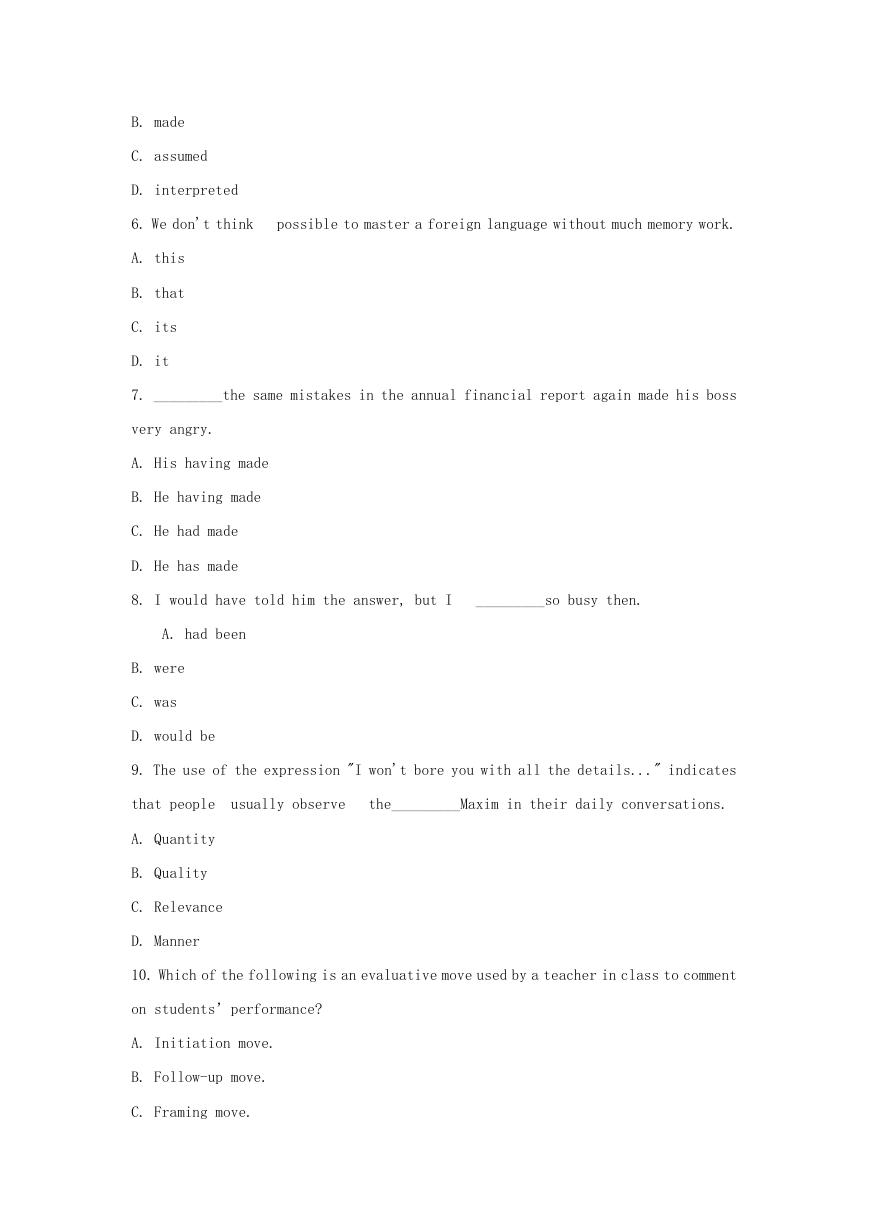
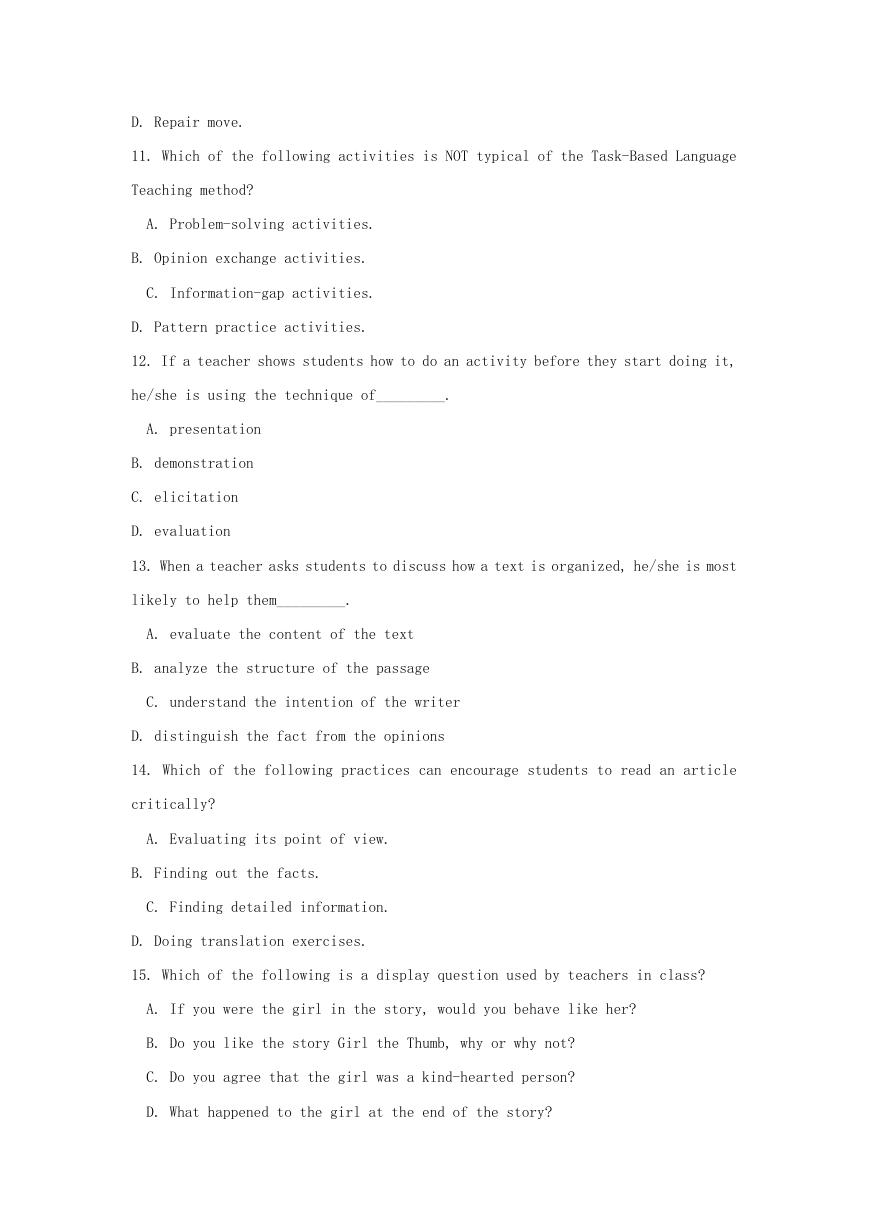
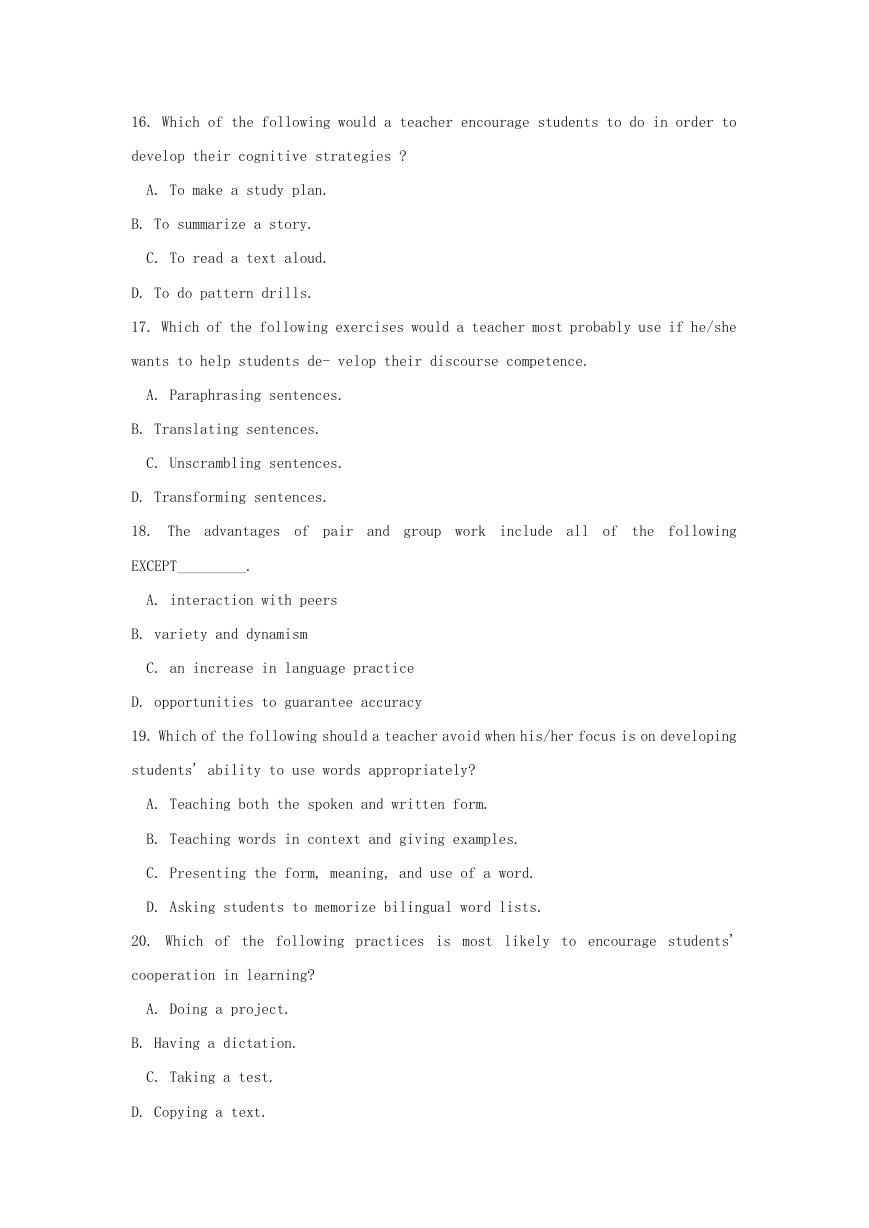

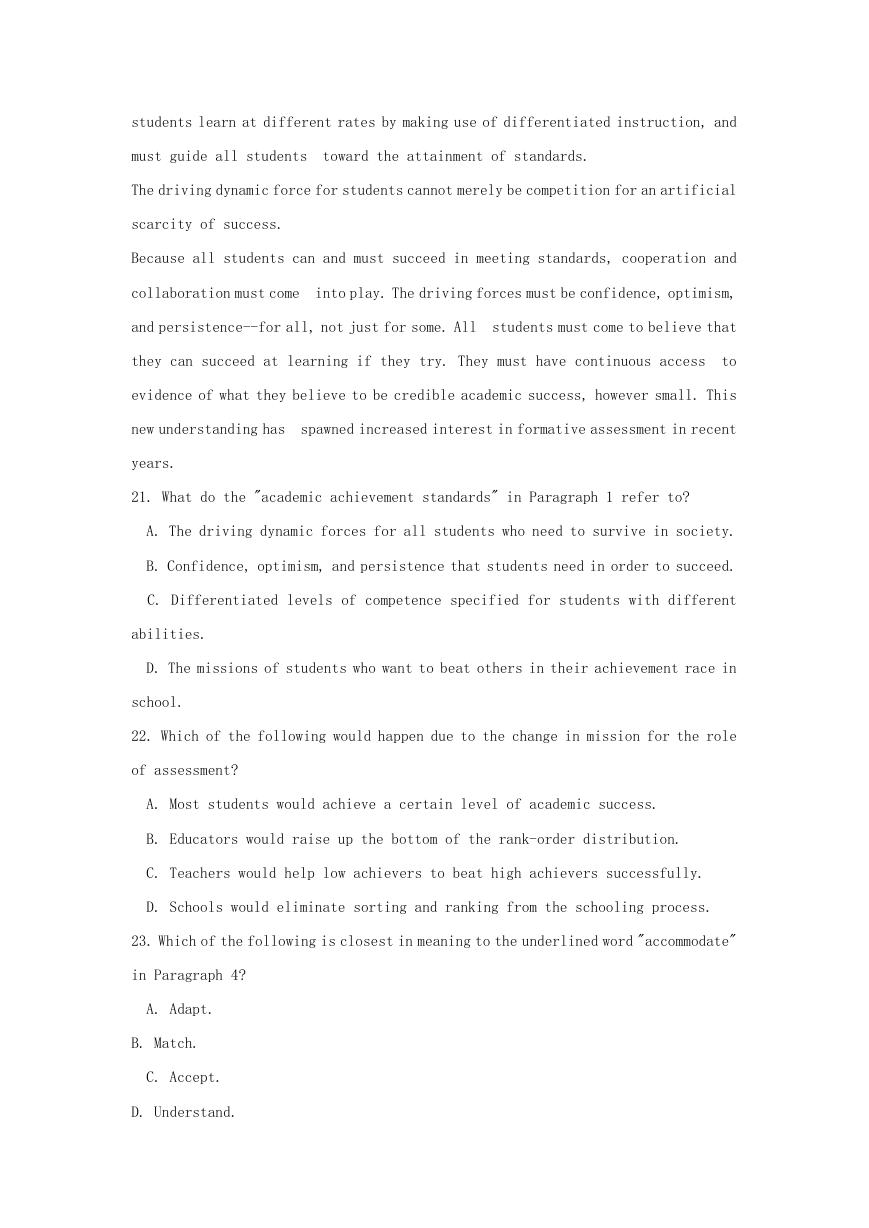
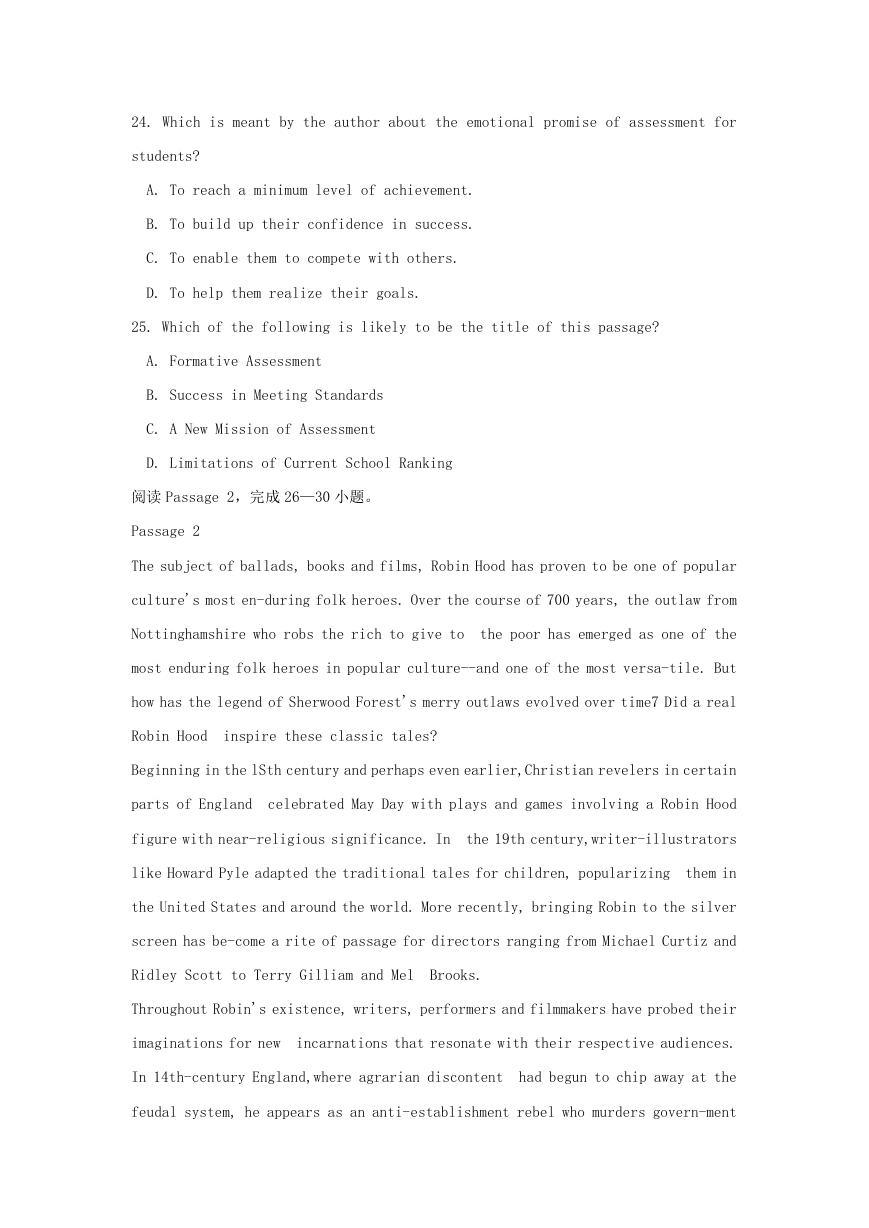









 2023年江西萍乡中考道德与法治真题及答案.doc
2023年江西萍乡中考道德与法治真题及答案.doc 2012年重庆南川中考生物真题及答案.doc
2012年重庆南川中考生物真题及答案.doc 2013年江西师范大学地理学综合及文艺理论基础考研真题.doc
2013年江西师范大学地理学综合及文艺理论基础考研真题.doc 2020年四川甘孜小升初语文真题及答案I卷.doc
2020年四川甘孜小升初语文真题及答案I卷.doc 2020年注册岩土工程师专业基础考试真题及答案.doc
2020年注册岩土工程师专业基础考试真题及答案.doc 2023-2024学年福建省厦门市九年级上学期数学月考试题及答案.doc
2023-2024学年福建省厦门市九年级上学期数学月考试题及答案.doc 2021-2022学年辽宁省沈阳市大东区九年级上学期语文期末试题及答案.doc
2021-2022学年辽宁省沈阳市大东区九年级上学期语文期末试题及答案.doc 2022-2023学年北京东城区初三第一学期物理期末试卷及答案.doc
2022-2023学年北京东城区初三第一学期物理期末试卷及答案.doc 2018上半年江西教师资格初中地理学科知识与教学能力真题及答案.doc
2018上半年江西教师资格初中地理学科知识与教学能力真题及答案.doc 2012年河北国家公务员申论考试真题及答案-省级.doc
2012年河北国家公务员申论考试真题及答案-省级.doc 2020-2021学年江苏省扬州市江都区邵樊片九年级上学期数学第一次质量检测试题及答案.doc
2020-2021学年江苏省扬州市江都区邵樊片九年级上学期数学第一次质量检测试题及答案.doc 2022下半年黑龙江教师资格证中学综合素质真题及答案.doc
2022下半年黑龙江教师资格证中学综合素质真题及答案.doc